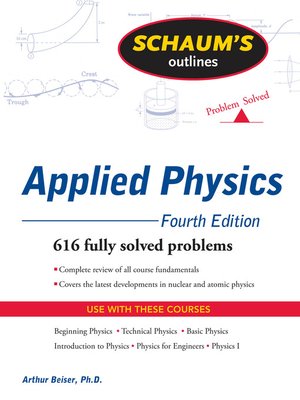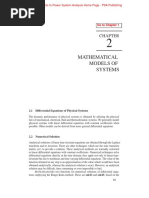Applied Differential Equations Spiegel Pdf Files
.Return to page for the first course APMA0330Return to page for the second course APMA0340Return to tutorial for the second course APMA0340Return to the for the course APMA0330Return to the for the course APMA0340. The attempt to solve physical problems led gradually to mathematical models involving an equation inwhich a function and its derivatives play important roles. However, the theoretical development of thisnew branch of mathematics-Ordinary Differential Equations-has its origins rooted in a small numberof mathematical problems. These problems and their solutions led to an independent discipline with thesolution of such equations an end in itself.According to some historians of mathematics, the study of differentialequations began in 1675, when (1646-1716) wrotethe equation. Mathematica is based on its own programming language, called.
- Applied Differential Equations Spiegel Pdf Files Free
- Applied Differential Equations Spiegel Pdf Files List
Unlike other programming languages, the philosophy of the Wolfram Language is to build as much knowledge about algorithms and about the world into the language as possible.There is nothing that can be done in Mathematica and absolutely cannot be done in other programming environments. For many problemshowever, especially those involving symbolic programming, solving aproblem in a language such as or will be eventually equivalentto re-implementing a subset of Mathematica (or other system forsymbolic manipulations) needed to solve the problem. The point isthat many things are done in Mathematica with less or a lot lesseffort and time, because a lot of both generic and specificfunctionality is already built in Mathematica.
And because it is sogeneral, this statement is expected to be true for almost any field where some computations, prototype or program design and development, simulations etc are used.Here are 10 good reasons (according to) to use Mathematica:. Multiparadigm language: the richness of the language allows to pick for any problem a programming paradigm orstyle which corresponds to it most directly. You spend most of the time thinking about the problem rather thanimplementation. The very high level of the language means that a lot of work is done for you by the system.
Interactivity. Mathematica is an interpreted language, which allows interactive and incrementalprogram development. The Mathematica front-end adds another layer of interactivity, being able to displayvarious forms of input and output (and this can be controlled programmatically).
Applied Differential Equations Spiegel Pdf Files Free
Programming in the large. The typically small size and high level of abstraction of the code allows a singleperson to manage substantial projects. There is also a built-in support for large projects through the system ofpackages.
Built-ins. Availability of thousands of built-in functions makes it possible to do sophisticated analysis veryquickly. Extended error message system (each built-in function can issue a lot of error messages on improper inputs)greatly simplifies debugging. Generality, higher-order functions and tight system integration. The very general principles of Mathematica,its uniform expression structure, generic nature of many built-in functions, and tight integration of all componentsallows to use all other built-in functions much easier than one would use libraries in other languages.
The Helpsystem is also uniform and it is immediate to learn the functionality of any built-in function that you have neverused before. Visualizations. Great dynamic and visualization capabilities.

Cross-platform. The Mathematica code developed in one environment or OS will work in exactly the sameway in all others where Mathematica is available. Connectivity: the developers keep increasing the number of file formats which Mathematica canunderstand and process. Also, tools like, J/Link, database connectivity etc. Allow one to connectMathematica to external programs.Backward compatibility: since the version 1 and the most recent developers arecareful to maintain very high level of backwards compatibility. This meansthat one should not worry too much that solutions developed in the currentversion will need a rewrite to work on the future versions (apart frompossible improvements related to availability of new built - in functions, ifone is so inclined).
Support for parallel and distributed computing.Mathematica is split into two parts, the kernel and the front end. Thekernel interprets expressions (Wolfram Language code) and actuallydoes the computation and returnsresult expressions. The front end is the window where you type in your commands, which in turn is a part of noteboos.The front end, designed by, provides a GUI, which allows the creation and editing of Notebook documentscontaining program code with pretty printing, formatted text together with results including typeset mathematics,graphics, GUI components, tables, and sounds. All contents and formatting can be generated algorithmically orinteractively edited. Most standard word processing capabilities are supported. It includes a spell-checker but doesnot spell check automatically as you type.Mathematica is launched by double-clicking on its icon or any other shortcut your computer system recognizes.Documents can be structured using a hierarchy of cells, which allow for outlining and sectioning of a document andsupport automatic numbering index creation. Documents can be presented in a slideshow environment for presentations.Notebooks and their contents are represented as Mathematica expressions that can be created, modified, oranalyzed by Mathematica programs.
This allows conversion to other formats.Help on Mathematica commands is always available through the help browser. The browser providesseveral ways to access the information. I usually select Documentation Center from thehelp menu to find the topic I need (there is a search option in the Documentation Center). The help menuhas the following options:Documentation Center(gives access to the documentation in outline form),Function Navigator(allows you to type in the name of a function and get its documentation), and many others.Mathematica notebooks can be converted to many other formats, such as HTML and PDF.
To do this, open thenotebook in Mathematica, choose File Save As, and use the drop-down menu to view the various formatsavailable. Conversions to other formats are also scriptable using the built-in Mathematica functionExport.Mathematica notebooks are structured interactive documents thatcan contain text, graphics, sound, calculations, typeset expressions, and userinterface elements.
Notebooks have the file extension.nb.Files of this type are automatically associated with Mathematica onsystems in which Mathematica is installed.Mathematica notebooks contain only printable, 7-bit ASCII charactersand are viewable and largely human-readable in any text editor. Thenotebook file format is a cross-platform format, meaning that aMathematica installation on any supported platform can read anddisplay a notebook that has been created on any other Mathematica installation on any other platform.Eventually, you may wish to produce your own notebooks, perhapswhen writing up solutions to homework.
You cancreate a document like this one, with headings, subheadings, and text cells (in addition to input/output cells), using the Styleoption from theFormatmenu at the top. It may be preferable, in somecases, to initialize the entire notebook at the beginning. You can dothis by going to the Evaluation menu and selectingEvaluate notebook. If this is how you want toinitialize the kernel, then you should do itat the beginning of your session.The first time you save the document, go the File menu, select theSave As option, and then enter a file name ending in '.nb'.
Applied Differential Equations Spiegel Pdf Files List

For example, to create a text cell (like this one), click between cells (orafter the last cell in your document), so thatMathematica is prepared to receive input. Then (using the mouse) go to theFormat menu, click on Style, and then select Text from the list of options. Whatever youthen type in the cell will be in text format.References.
.Applied Differential Equations, 3rd Edition. Heroes of might and magic cheats.